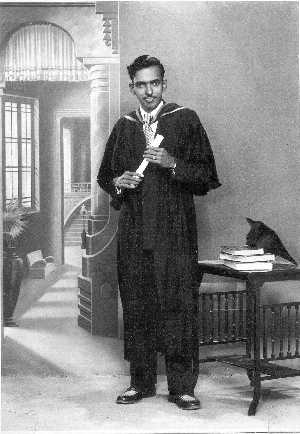

Home | Biodata | Biography | Photo Gallery | Publications | Tributes
Information Theory

 |

Home | Biodata | Biography | Photo Gallery | Publications | Tributes Information Theory |
 |
Information Theory and its Applications [5]
Information Theory originated in the work of C.E.Shannon in 1948 and he developed a mathematical scheme in which the transmission of information in communication systems was defined quantitatively. Some results obtained in information theory have been successfully applied to fields such as statistics, linguistics, biology, physics, genetics, neuro-physiology and philosophy.
Siromoney took a course on Information theory, then a fairly new subject, in Columbia University in 1958-59. On his return to Tambaram, he started to work and published the results in an International journal as early as 1963.[3]
He formed one of the earliest groups in India and found many applications in the Indian context. He applied information theory to the Tamil language[3] and his group worked on Telugu[8] and Kannada too. As a first step, a large sample of modern Tamil Prose was taken and different proportions of the occurrence of the letters worked out. This result was directly applied to construct an efficient telegraphic code, and to improve the keyboard for the typewriter in Tamil. After reducing the number of symbols required to form letters of the Tamil alphabet, he constructed the first ever keyboard of a teleprinter in Tamil.[2]
Information Theory has been applied to music to distinguish the styles of composers like Schubert, Schumann and Mendelssohn. Siromoney compared the styles of three famous Indian composers of Karnatic Music, Thiagarajah (1767-1847), Dikshithar (1776-1836) and Shyama Sastrigal (1772-1827), who though contemporaries had distinct styles of their own.[6]
As an application in the field of Psychology[4], he suggested a simple measure to grade the subjects roughly according to their familiarity with a foreign language, in this case, English. This test is of great practical value in a place like the Madras Christian College, where students come from very different backgrounds.
He defined two types of General Dirichlet's Series Distribution[7] and showed that they were essentially different. Deriving the Logarithmic Series Distribution[1] as a special case, Shannon's entropy was used to show the difference between the two types. The results are applied to two types of biological populations, having made an in-depth study of the population of birds and butterflies at Tambaram to gain sufficient insight. Birds and butterfly populations have been shown to be distributed in the logarithmic series type 2 form, whereas rats with fleas are known to be distributed in the log series type 1 form.
At that time there was serious controversies published in Information and Control between two eminent scientists, Simon and Mandlebrot and Siromoney's discovery that the two distributions are essentially different solved this issue. Siromoney[7] showed that Shannon's entropy which is a parameter in the logarithmic distribution type 1 increases with the size of the sample of insects. Siromoney cautioned that considerable care should be taken before applying standard statistical technique to the type 2 distributions as they are basically compound distributions. Type 1 log series distribution is illustrated by the sequence of wet days from data collected locally on campus between 1932 and 1962. Shannon's entropy is used as a measure of predictability of the weather.[5]
Compiled from the Ph.D. thesis of Gift Siromoney,
Rani Siromoney.
Publications
